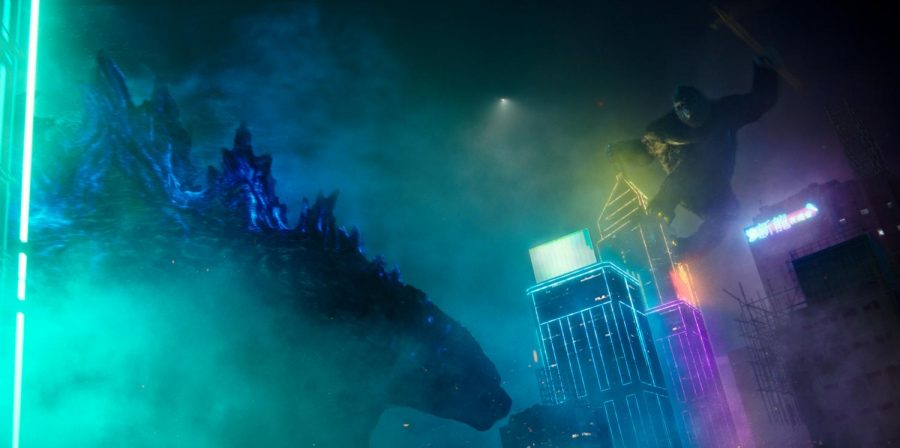This is what we’re thinking: we’ll make a big monkey fight a big lizard. We’ll cast that girl from “Stranger Things” as a woke, rebellious teenager. The FBI agent in “The Wolf of Wall Street”? He’ll be her dad — and he’ll have, like, two memorable lines. The guy from that “Tarzan” remake? He’ll convince everybody that the earth is hollow. It’ll take us 5 years to make.
Oh, and it’ll cost $200 million.
Since watching “Godzilla vs. Kong” a few weeks ago, I’ve come to a realization far more amusing than any line in the movie. At some point between January and October of 2015, a variation on the above statement was made to a group of movie producers at Legendary Entertainment. Even harder to believe is what happened next. Despite all its absurdity, Legendary responded by throwing nearly a quarter of a billion dollars at the idea. It’s been five years since that pitch meeting took place, and it is nothing short of a mystery to me that Hollywood saw something in “Godzilla vs. Kong.”
I am most shocked, however, by the fact that I also see something in the movie — a flashy and entertaining blockbuster that, after a year of closed theaters, could not have come at a better moment.
“Godzilla vs. Kong” is the fourth installment in Warner Brothers’ MonsterVerse franchise, a series that began as a dramatic homage to the monster films of the mid-20th century. It has since shifted its focus to a set of recognizable and comforting tropes: elaborate battle scenes, stunning visuals, cliche human relationships, and the never-ending task of saving humanity from destruction. This installment sees the franchise come into its own as a technically grandiose, narratively modest staple of the action genre.
Directed by Adam Wingard, the movie employs the MonsterVerse formula amid a new and extravagant dilemma: on his way to a new habitat, King Kong crosses paths with a newly hostile Godzilla. Though the reason for this provocation (an ill-defined corporate interference with Godzilla) is seemingly integral to the story, accounting for a majority of the film’s sparse and cliche dialogue, Wingard deliberately pays it little attention.
And that’s the right move. Let me assure you — “Godzilla vs. Kong” is about nothing more than a gigantic ape brawling with a gigantic lizard.
Besides a few moments of human-centered plot, most of which happen so that we can return to the action, a seeming majority of the movie’s runtime is dedicated to this fight. It happens above ground, underground, in the ocean. It happens in cities and in different parts of the globe. No matter the loose and sometimes nonexistent narrative on which it rests, the beast-on-beast fighting throughout “Godzilla vs. Kong” is enthralling. The entertainment that Kong’s punches and Godzilla’s cold-blooded, reptilian snarls provide is one which rejects intellect and embraces the task of its genre: entertain, by any means necessary.
What results is an experience that provides great stimulation but requires very little from its audience. In fact, it’s most enjoyable when viewed as a chance to turn one’s mind off — while I took notes for the first half of the film, I found it much more enjoyable to take a passive role as a viewer. In letting its flash and charming stupidity wash over me, I found a specific euphoria that, when viewed in a theater, could serve as an antidote to pandemic-induced malaise.
Despite its simplicity, “Godzilla vs. Kong” is still worthy of acclaim on the basis of entertainment — especially in regard to its director’s performance. Behind the movie’s bounty of indulgent battle moments is Wingard’s orchestration of cast and crew. His actors bring shape to the story without drawing away from the action. His special effects team makes the proceedings of Kong and Godzilla that much more indulgent. The slaps and punches are vivid. The monsters themselves are stunningly realistic. Ironically, Wingard’s finest moments as a director are those that occur between fight scenes — short breaks that allow our beasts to prepare for the next battle and give the movie’s human characters a chance to bring shape to the story.
Brian Tyree Henry, who plays Bernie Hayes, a goofy yet altruistic conspiracy theorist, reflected on Wingard’s efforts to humanize the story and its two beasts in a conversation with WSN.
“Adam made both [Godzilla and Kong] incredibly complex. You actually care about both of them while also caring about the humans,” said Henry. “In most movies like this, it’s just a body count. With this one, you care about the humans that are championing for both teams. Everyone has skin in the game.”
It’s this semblance of a human touch that makes the arrival of “Godzilla vs. Kong” so timely. Julian Dennison, who provides comic relief in the role of Josh Valentine, told WSN that the impact of the movie during a pandemic will be far more important than its contribution to cinema.
“The world’s in an uncertain place,” he said. “This is what we need. I miss going to theaters with people I don’t know — it’s so cool that people are able to go back, watch a big blockbuster movie, and really enjoy themselves.”
“Godzilla vs. Kong” does its job. A departure from reality is more valuable now than ever — who are we to ask for more?
Email JP Pak at [email protected].


























































































































































